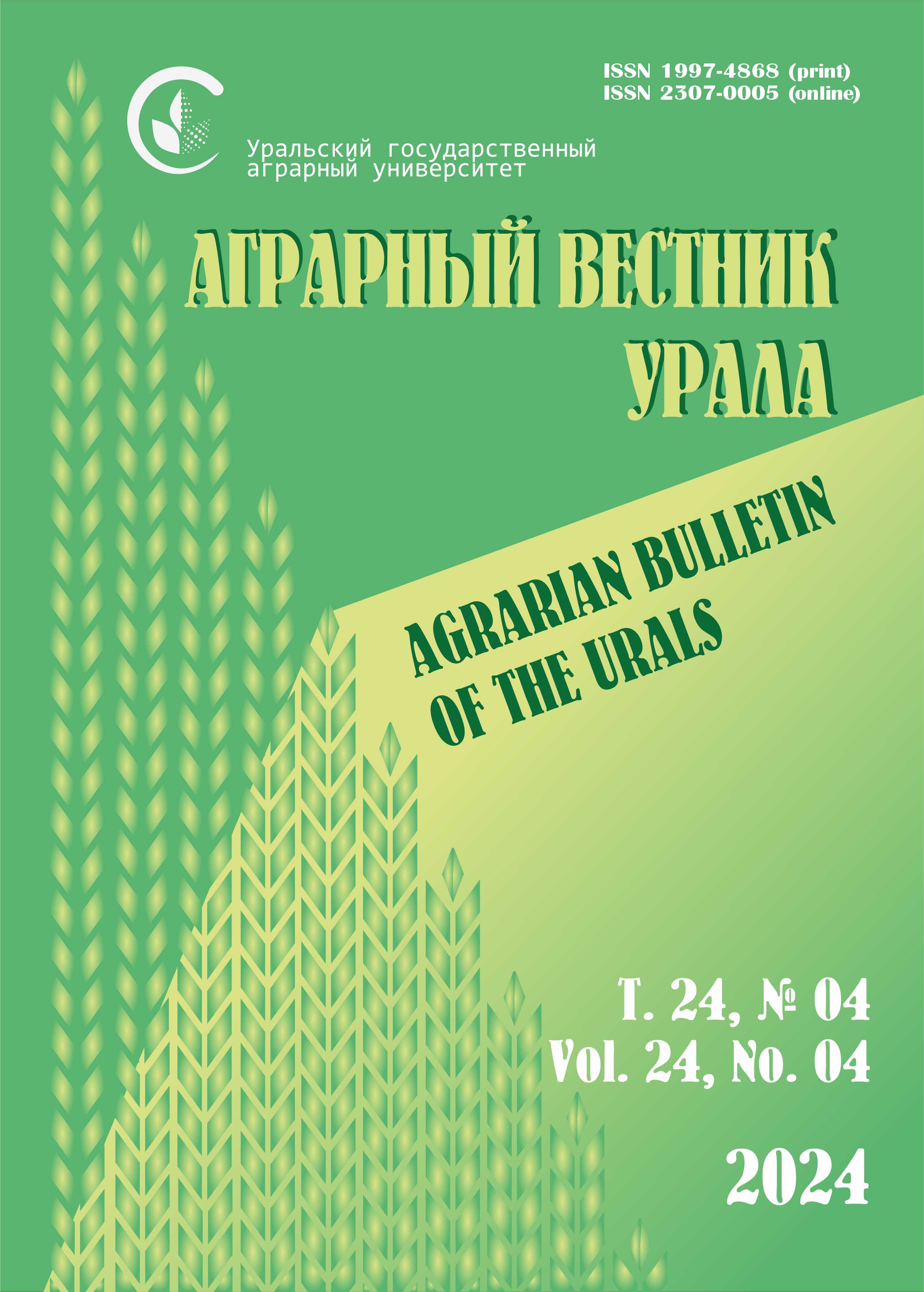Russian Federation
Russian Federation
Abstract. The relevance of the study is determined by the need to adapt the Russian food market and its individual segments to new global challenges to ensure the country's food security. The purpose of the scientific work is to study changes in the dynamics and structure of production and consumption of meat and meat products, to substantiate the directions for the development of individual segments of the meat and meat products market under the conditions of sanctions restrictions. Methods. General cognition methods such as abstract-logical, monographic methods, comparison methods, dynamic and structural analysis were used in the course of investigations. Results. Multidirectional trends in the development of individual segments of the meat products market have been identified. There is positive trend in production and consumption of poultry and pig meat. Opposite trends are in production and consumption of cattle meat. Multidirectional trends indicate different development models for meat product market segments. Excessive growth in poultry and pork production volumes could lead to a deterioration in the financial situation in the industries. Insufficient cattle meat production reduces the physical and economic food availability for households. In these conditions, agri-food policy must take into account the balanced development of food chains, justify the mechanisms of structural maneuver of resources and structural transformations, and specify targets in the field of import substitution. The scientific novelty of the study is substantiation of the directions for the development of various segments of the meat products market based on the identified trends and features of their functioning under sanctions restrictions.
market capacity, meat product chain, sanctions, opportunities, restrictions, production, consumption
1. Olney D. K., Galli A., Kumar N., Alderman H., Go A., Raza A. Social assistance programme impacts on women’s and children’s diets and nutritional status // Maternal & Child Nutrition. 2022. Vol. 18, No. 4. DOI:https://doi.org/10.1111/mcn.13378 (data obrascheniya 03.09.2023).
2. Polozhenie del na rynkah sel'skohozyaystvennoy produkcii – 2022. Geografiya torgovli prodovol'stviem i sel'skohozyaystvennoy produkciey: politicheskie podhody v interesah ustoychivogo razvitiya. Rim, FAO. 2022. Kratkiy obzor. DOI:https://doi.org/10.4060/cc0475ru.
3. Götz L., Heigermoser M., Jamali Jaghdani T. Russia’s food security and impact on agri-food trade. // In: Wegren S. K. Nilssen F. (eds.) Russia’s role in the contemporary international agri-food trade system. Palgrave Macmillan: Cham, 2022. Pp 115–137. DOI:https://doi.org/10.1007/978-3-030-77451-6_5.
4. Espitia A., Rocha N., Ruta M. Covid-19 and Food Protectionism: The Impact of the Pandemic and Export Restrictions on World Food Markets World Bank Policy: Research Working Paper [Elektronnyy resurs]. 2020. No. 9253. URL: https://ssrn.com/abstract=3605887 (data obrascheniya: 10.08.2023).
5. Semeko G. V. Mirovoy prodovol'stvennyy rynok: sovremennye vyzovy i perspektivy // Ekonomicheskie i social'nye problemy Rossii. 2023. № 1. S. 19–43. DOI: https://doi.org/10.31249/espr/2023.01.01; EDN: https://elibrary.ru/ZUDPBH
6. Beglaryan G. A., Ivanov G. N., Kalugina P. P., Polovinchikova A. V. Sankcionnaya politika SShA i evropeyskih stran v otnoshenii Rossii: povorot nachala 2022 goda // Ekonomicheskie otnosheniya. 2022. T. 12, № 3. S. 367–388. DOI:https://doi.org/10.18334/eo.12.3.115086. EDN: https://elibrary.ru/XUDOYN
7. Vliyanie sankciy na sel'skoe hozyaystvo. Obzor. Konsaltingovaya gruppa «Tekart» [Elektronnyy resurs]. URL: https://techart.ru/download/insights/0010/5145/add_files/agriculture-sanctions-techart-1651154442.pdf?ysclid=lmerc47vhz402690493 (data obrascheniya: 15.09.2023).
8. Vorotnikov I. L., Sukhanova I. F., Lyavina M., Yu. Glukhova M. I., Petrov K. A. Economic sanctions and import substitution [Elektronnyy resurs] // Entrepreneurship and Sustainability Issues. 2019. Vol. 6, No. 4. Pp. 1872–1883. URL: https://jssidoi.org/jesi/uploads/articles/24/Vorotnikov_Economic_sanctions_an d_import_substitution.pdf (data obrascheniya: 15.10.2023). DOI: https://doi.org/10.9770/jesi.2019.6.4(23); EDN: https://elibrary.ru/AUAPNO
9. Suhanova I. F., Lyavina M. Yu. Prodovol'stvennaya bezopasnost' v Rossii v usloviyah sankcionnyh ogranicheniy // International Agricultural Journal. 2023. T. 66. № 1. S. 171–189. DOI:https://doi.org/10.55186/25876740_2023_7_1_14. EDN: https://elibrary.ru/GLZFPV
10. Makarevich L. O., Ulez'ko A. V. Osobennosti organizacii produktovyh cepochek v agroprodovol'stvennom komplekse i perspektivy ih razvitiya // Vestnik Voronezhskogo gosudarstvennogo agrarnogo universiteta. 2020. № 3 (66). S. 136–145. DOI:https://doi.org/10.17238/issn2071-2243.2020.3.136. EDN: https://elibrary.ru/JUXNAG
11. Global'nye cepochki sozdaniya dobavlennoy stoimosti kak faktor povysheniya effektivnosti ekonomiki regiona: monografiya / S. N. Bocharov, V. I. Belyaev, M. M. Butakova [i dr.]. Barnaul: Izd-vo AltGU, 2019. 216 s. EDN: https://elibrary.ru/NPDODY
12. Loyko V. I., Baranovskaya T. P. Upravlenie proizvodstvennym processom v sel'skom hozyaystve na osnove modelirovaniya i ocenki cepochek sozdaniya dobavlennoy stoimosti // Politematicheskiy setevoy elektronnyy nauchnyy zhurnal Kubanskogo gosudarstvennogo agrarnogo universiteta. 2020. № 156. S. 211–227. DOI:https://doi.org/10.21515/.1990-4665-156-015. DOI: https://doi.org/10.21515/1990-4665-156-015; EDN: https://elibrary.ru/TFHTBE
13. Doktrina prodovol'stvennoy bezopasnosti Rossiyskoy Federacii (utverzhdena Ukazom Prezidenta Rossiyskoy Federacii ot 21 yanvarya 2020 g. № 20) [Elektronnyy resurs]. URL: http://www.consultant.ru/document/cons_doc_LAW_343386 (data obrascheniya: 10.10.2023).
14. Fanzo J., Haddad L., McLaren R., Marshall Q., Davis C., et al. The food systems dashboard is a new tool to inform better food policy // Nature Food. 2020. Vol. 5 (13). Pp. 1–4.
15. Van Berkum S., Ruben R. Exploring a food system index for understanding food system transformation processes // Food Security. 2021. No. 13. Pp. 1179–1191. DOI:https://doi.org/10.1007/s12571-021-01192-6. EDN: https://elibrary.ru/YJEERM
16. Bogomolova I. P., Kotareva A. V., Kotareva A. O. Ocenka sovremennogo sostoyaniya i perspektiv razvitiya otechestvennogo rynka myasa i myasoproduktov // Vestnik Kurskoy gosudarstvennoy sel'skohozyaystvennoy akademii. 2019. № 1. S. 105–112. EDN: https://elibrary.ru/YZPYHB
17. Balansy prodovol'stvennyh resursov po Rossiyskoy Federacii [Elektronnyy resurs]. URL: http://gks.ru›free_doc/new_site/business/sx/bal_2.xls (data obrascheniya: 10.09.2023).
18. Yakovenko N. A., Ivanenko I. S. Transformaciya modeley razvitiya myasoproduktovogopodkompleksa Rossii v usloviyah sankcionnyh ogranicheniy // Regional'nye agrosistemy: ekonomika i sociologiya. 2023. № 3. S. 4–11. EDN: https://elibrary.ru/ATTIDK
19. Ostapenko T. V. Mezhotraslevye vzaimodeystviya kak faktor ekonomicheskoy ustoychivosti agroprodovol'stvennogo kompleksa Rossii // Sovremennye tendencii i riski ustoychivogo razvitiya nacional'nogo agroprodovol'stvennogo kompleksa v usloviyah global'nyh vyzovov: sbornik materialov Vserossiyskoy nauchnoy konferencii «Ostrovskie chteniya». Saratov, 2023. S. 89–93.
20. Yakovenko N. A., Ivanenko I. S., Voronov A. S., Saninsky S. A. Trends in the formation of the commodity composition of the Russia’s agrofood exports // Journal of Advanced Research in Dynamical and Control Systems. 2020. Vol. 12, No. 5. Special Issue. Pp. 337–345. DOI: https://doi.org/10.5373/JARDCS/V12SP5/20201766; EDN: https://elibrary.ru/NRHTXD
21. Bogomolova I. P., Kotarev A. V. Realizaciya mehanizma gosudarstvennogo reguliruyuschego upravleniya s cel'yu razvitiya myasnogo proizvodstva i obespecheniya prodovol'stvennoy bezopasnosti // Region: sistemy, ekonomika, upravlenie. 2019. № 1 (44). S. 53–65. EDN: https://elibrary.ru/VXDUIA
22. Rudnev M. Yu., Vorotnikov I. L., Rudneva O. N. Teoretiko-metodologicheskie osnovy obosnovaniya napravleniy kompleksnogo razvitiya predpriyatiy myasopererabatyvayuschey promyshlennosti // Ekonomika i predprinimatel'stvo. 2023. № 6 (155). S. 1140–1143. DOI: https://doi.org/10.34925/EIP.2023.155.6.212; EDN: https://elibrary.ru/PWRNME









